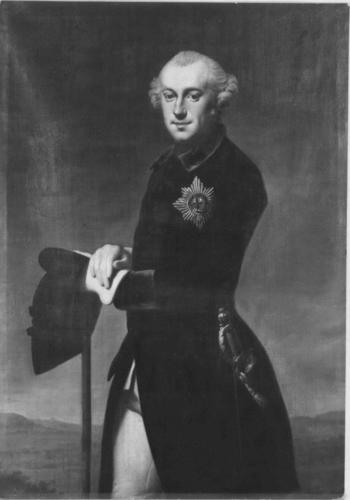-
1 of 253523 objects
Karl II Wilhelm Ferdinand, Duke of Brunswick-Wolfenbüttel (1735-1806) 1762-65
Oil on canvas | 137.2 x 98.4 cm (support, canvas/panel/stretcher external) | RCIN 401370

Attributed to Johann Georg Ziesenis (1716-76)
Karl II Wilhelm Ferdinand, Duke of Brunswick-Wolfenbüttel (1735-1806) 1762-65
-
Born in Copenhagen in 1716, Johann Georg Ziesenis was a pupil of his father Johan Jürgen Ziesenis. He became a German citizen in 1743 and was first appointed court painter in Zweibrücken, then in Mannheim. In 1760 he entered into the service of George II of Hannover and, subsequently, George III; Ziesenis also worked in Berlin and Brunswick. The Royal Collection owns a significant amount of Ziesenis portraits, illustrating members of various eighteenth-century noble German dynasties – notably from the houses of Mecklenburg-Streliz and Brunswick-Wolfenbüttel.
Producing around 260 works in his lifetime, most of which were portraits, Ziesenis is remembered for his intimate portrayals of the future wife of George III, Charlotte of Mecklenburg-Streliz, Crown Prince Frederick and Frederick II. He began his career working in a traditional baroque style but, inspired by Rubens and Van Dyck, effected a transformation in the 1750s, introducing a heightened psychology to his character studies. Ziesenis practised a new type of enlightened portraiture, the private court portrait. He depicted his subjects at ease in natural surroundings, an emphasis on education and worldliness rather than on power. His biographer, F. F. Kuntze, states that in invention and execution Ziesenis was the highpoint of eighteenth-century German portraiture and his best work ranks alongside the great painters of the English enlightenment.
In the later part of his career, Ziesenis' art exemplified the period of Zopfstil or Citizen's Rococo, literally a "pig-tail style" coined after Louis XVI and the waning Ancien Regime. This new style stood at a transition point between late Rococo and the burgeoning reprisal of stark, Hellenic Classicism in the hands of Winckelmann, best displayed in the furniture of the time. Ziesenis' portraits of this period introduce a certain air of civic responsibility and mark a departure from the florid pleasure gardens of Rococo fashion.
Karl William Ferdinand was head of Brunswick-Wolfenbüttel, a princely state of the Holy Roman Empire. In 1764 he married Princess Augusta, a sister of George III of Great Britain. He served in the Severn Years' War under his uncle, Duke Ferdinand of Brunswick-Wolfenbüttel (1721-92), and with the Duke of Cumberland, successfully defending Hanover from French invasion. This naturally earned the gratitude of the Hanoverian monarchs, with the result that the Royal Collection has three pairs of portraits depicting this heroic uncle and nephew: this pair (RCIN 401370 & 401379), another of similar compositions (RCIN 405906-7) and another by Johann Heinrich Tischbein (RCIN 404638 and 404640). Karl II fought subsequently in the War of Bavarian Succession and the Invasion of the Netherlands, becoming Generalfeldmarschall of the Kingdom of Prussia in 1787. This pair is identically framed in extravagant Rococo frames. In this portrait the Duke wears a blue velvet frock coat with the star of the Garter.Provenance
Presumably acquired by George IV; recorded in the store at Carlton House in 1816 (no 274) and 1819 (no 289); subsequently at Windsor Castle (Room 255)
-
Creator(s)
Previously attributed to after (artist)(nationality) -
Medium and techniques
Oil on canvas
Measurements
137.2 x 98.4 cm (support, canvas/panel/stretcher external)
184.9 x 133.9 x 12.3 cm (frame, external)
Alternative title(s)
Charles II William Ferdinand, Duke of Brunswick-Wolfenbüttel (1735-1806)
Charles I, Duke of Brunswick-Wolfenbüttel (1713-1780), previously identified as